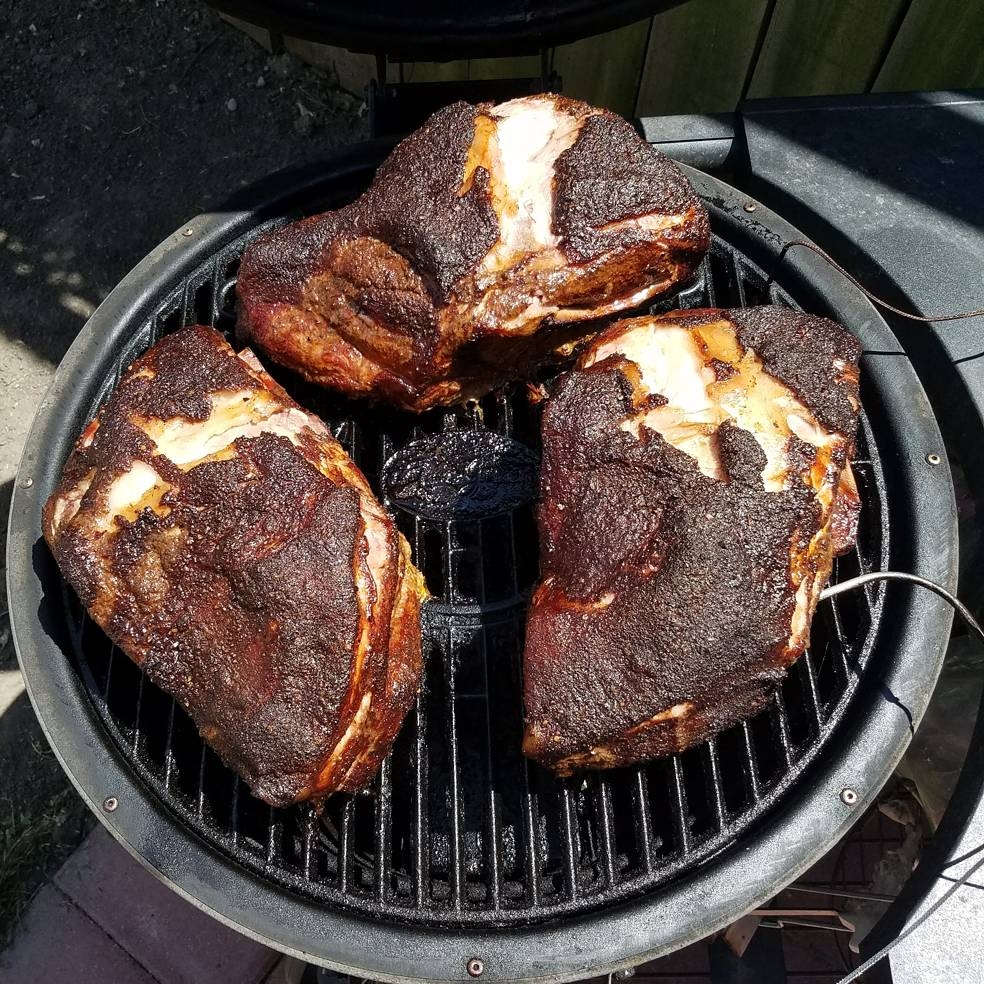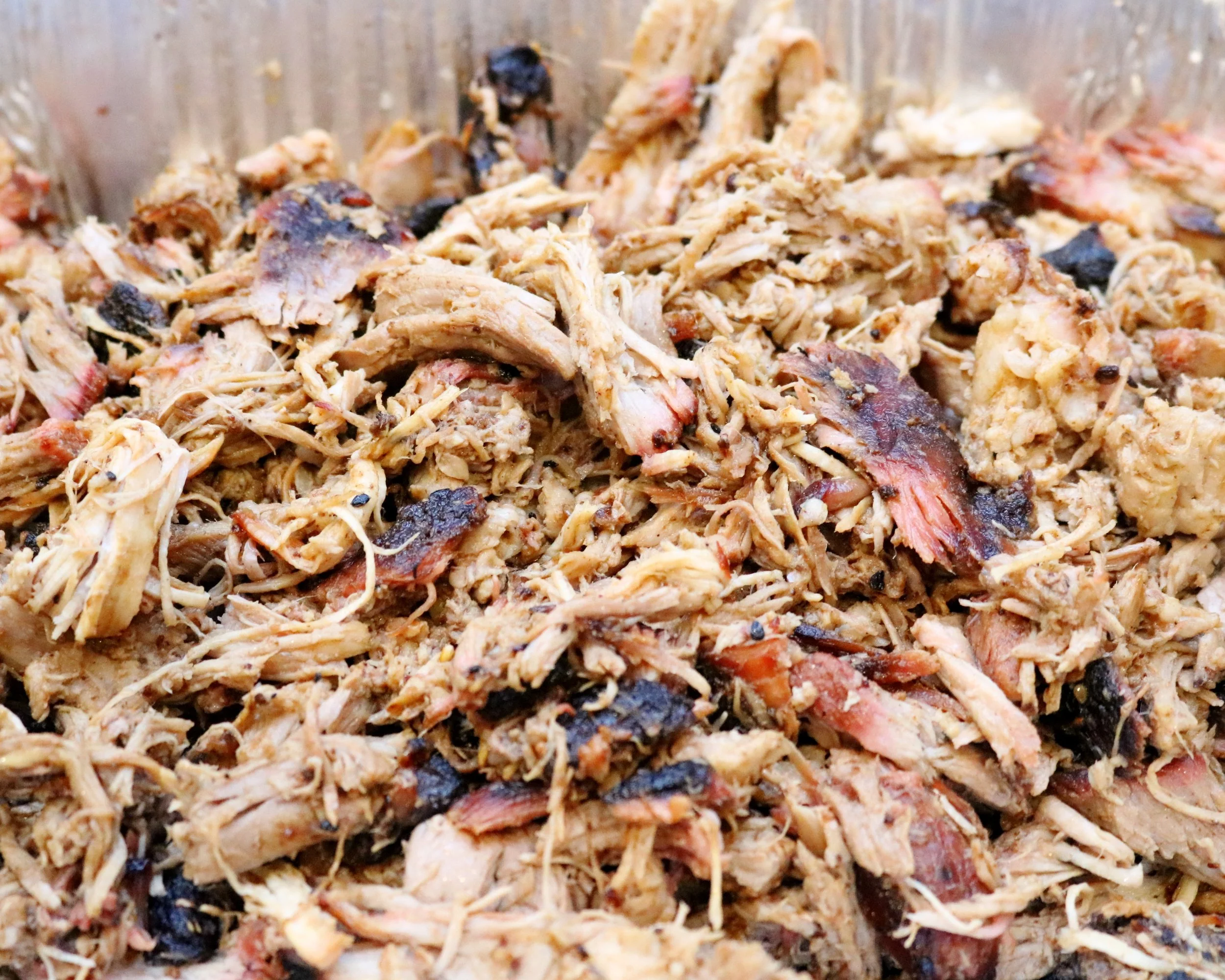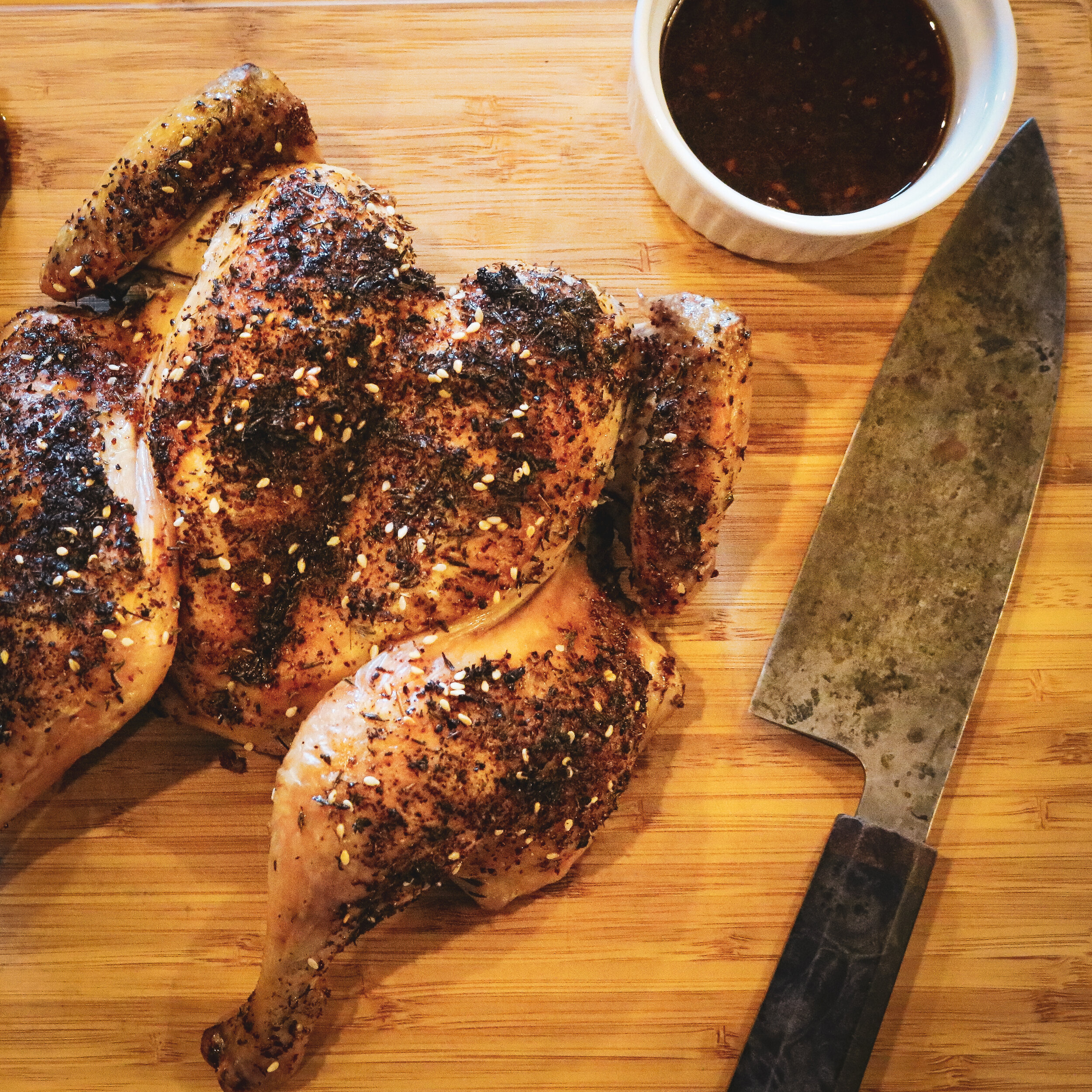Spatchcocked Smoked Turkey (or Chicken)

We’ve been making this style of turkey for Thanksgiving for several years now and it’s a showstopper. The result is a moist bird with crispy, flavorful skin. Extra bonus, by cooking the bird on the smoker or grill, you free up valuable space in the oven.
Ingredients
1 fresh turkey or 1 large, fresh chicken*
Kitchen/poultry shears
Smoker (or grill set up for indirect cooking)
Apple, Cherry, or Pecan wood chunks
Disposable foil tray (optional)
Kosher salt
Fresh ground black pepper
For the brine:
1 cup brown sugar
1 cup kosher salt
For the herb butter:
1 to 1 1/2 sticks of unsalted butter, at room temperature (use more or less depending on the size of your bird)
1/4 cup parsley, finely chopped
1/8 cup thyme leaves, lightly chopped (from about 4-5 sprigs)
1/8 cup sage leaves, finely chopped
2 teaspoons kosher salt
1 teaspoon freshly ground black pepper
Instructions
The Night Before
Make the Brine:
In a large stock pot, dissolve 1 cup kosher salt and 1 cup brown sugar in about 2 cups of hot water. I usually just boil about 3 cups of water in my electric kettle, pour the water into a large stock pot and add the sugar and salt. Once the mixture is mostly dissolved, add about 3 cups of ice to the solution to cool it down. Let the ice fully melt and then add in 2 cups of cold water (the amount of ice and water isn't really critical here). Your brine should feel cool by this point, but if the brine still feels warm, pop your stock pot into the fridge for a bit or add some more ice. You don't want to add the bird to a warm brine.
Spatchcock the Bird:
Once the brine is ready or while its cooling, remove the turkey from its packaging. Pat dry. Position the turkey breast side down. Use the poultry shears to cut all along one side of the backbone. Repeat on the other side and remove the backbone (toss it or save it for making stock). Turn the bird over, opening it up a bit as you do. Firmly press into the breast bone of the of the turkey to break it. Flatten the bird out.
Once the turkey is spatchcocked, place it into the stock pot. If needed, add cold water to the pot until the bird is fully immersed. If the bird is floating a bit, you can also fold a few sheets of paper towel together and gently place it over the top of the brine. This will make sure that any portion of the bird that wants to pop out the top of the liquid is still kept covered with brine. Cover and place in the fridge overnight.
The day of
About 4 hours before you plan to start smoking, arrange a cooling rack inside a baking sheet. Remove the turkey from the brine and place on the rack, skin side down. Pat the underside dry with a paper towel. Flip the bird over (skin side up) and pat dry again. Sprinkle the skin with a little salt and place the turkey, uncovered, into the fridge. This steps helps to dry out the skin a bit. Meanwhile, set out the butter to come to room temperature.
Spatchcocked, raw chicken on a cooling rack in a baking sheet.
Smoker Prep:
When you’re ready to start cooking, remove the turkey from the fridge and let it hang out at room temperature while you start the charcoal for the smoker. You're aiming for a temperature of about 325°F on the smoker. When the charcoal is about ready to go, add the hardwood chucks to the top of the pile. Place the disposable foil tray on a lower rack of the smoker (if you have multiple racks, or on the base of the grill if you're using a charcoal grill set up for smoking/indirect heat). Fill the tray with about a half inch of water. Place the upper rack into the smoker and close the lid.
Make the Herb Butter and Finish Prepping the Turkey:
Make the herb butter by combining the softened butter, herbs, salt, and pepper in a small bowl. Mix well. Pat the turkey dry again with paper towels. Season the underside with salt and pepper. Carefully slide your fingers between the skin and the meat of the turkey to make pockets. Work half of the herb butter under the skin, making sure to get some on the legs and breasts. Spread the other half of the butter all over the top of the skin. Place the turkey into the smoker, skin side up, positioned over the foil tray. The foil tray isn't required, but it certainly helps with clean up and can add moisture to the inside of the smoker to aid in cooking.
Spatchcocked, raw chicken with herb butter under and over the skin. Clearly, this is no time to be a perfectionist.
Insert a thermometer probe into one of the thighs. Make sure the probe is not in contact with the bone. Guide the probe wire out to the side of the smoker and close down the lid. You can go ahead and plug the probe into the temperature display unit, but I usually don't start actively monitoring the temp of the turkey until about hour into the smoke time.
Cook:
The cook time will be highly dependent on the size of the bird. For a 7 lb. chicken, expect a smoke time of at least an hour and a half. For a 20 lb. turkey, it will probably be at least two hours. The internal temperature is your real key though, you’re aiming for about 160°F. Resist the urge to open the smoker and check on the bird too frequently. When the thigh registers 160°F, use an instant thermometer or the probe to check the temperature of the breast meat and maybe the other thigh as well (better to make sure it’s done cooking before removing it from the smoker). When the turkey is ready, carefully lift it off the grate and onto a baking sheet, roasting pan, or foil tray.
Rest & Carve:
Allow the bird to rest at room temperature for about 30-45 minutes (leave the bird uncovered to avoid making the skin soggy - but you can loosely tent with foil if you feel the need). After resting, move the bird to a carving board and get cutting. I usually remove the legs and thighs first, followed by the wings. Remove each of the breasts from the turkey next - they’re easier to carve into slices once they’re flat on the cutting board.
You can save the carcass for stock if you’d like, but I have found the smoke flavor can overpower a stock.
Notes
*You can use frozen poultry as well, but make sure it is pretty much thawed by the time you’re starting. The overnight brine will help finish thawing out the bird all the way.
Avoid any bird that has been packed with a saline or saltwater solution (many are, so look at the labels carefully; even better, try to buy poultry fresh from a local producer). If you use one packed in saline, the extra brining step in this recipe will end up producing a rubbery meat that is deceptive to your probe thermometers (it’ll register as being fully cooked, when in fact, it’s still under your target temp). If all you can find is a bird that is packed in saline, skip the brining step altogether. Start out by just spatchcocking the bird and placing on the rack with a little salt to dry out for about four hours prior to smoking.
How to guide for smoking a spatchcocked turkey or chicken. Overnight brine, drying time, plus an herb butter under and over the skin.







